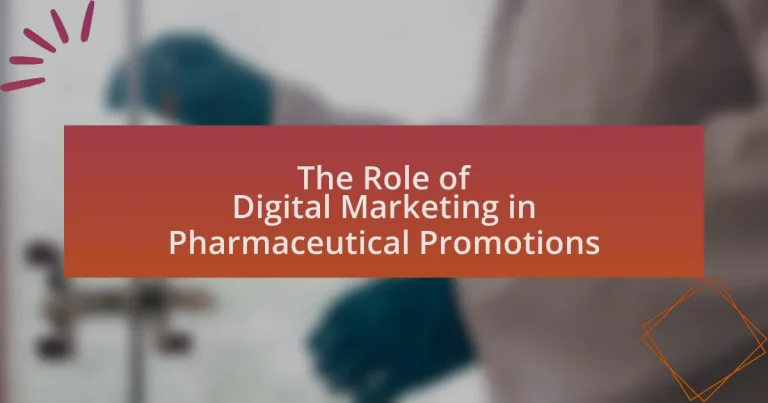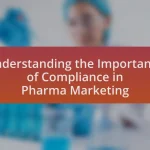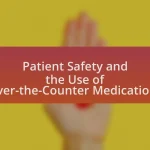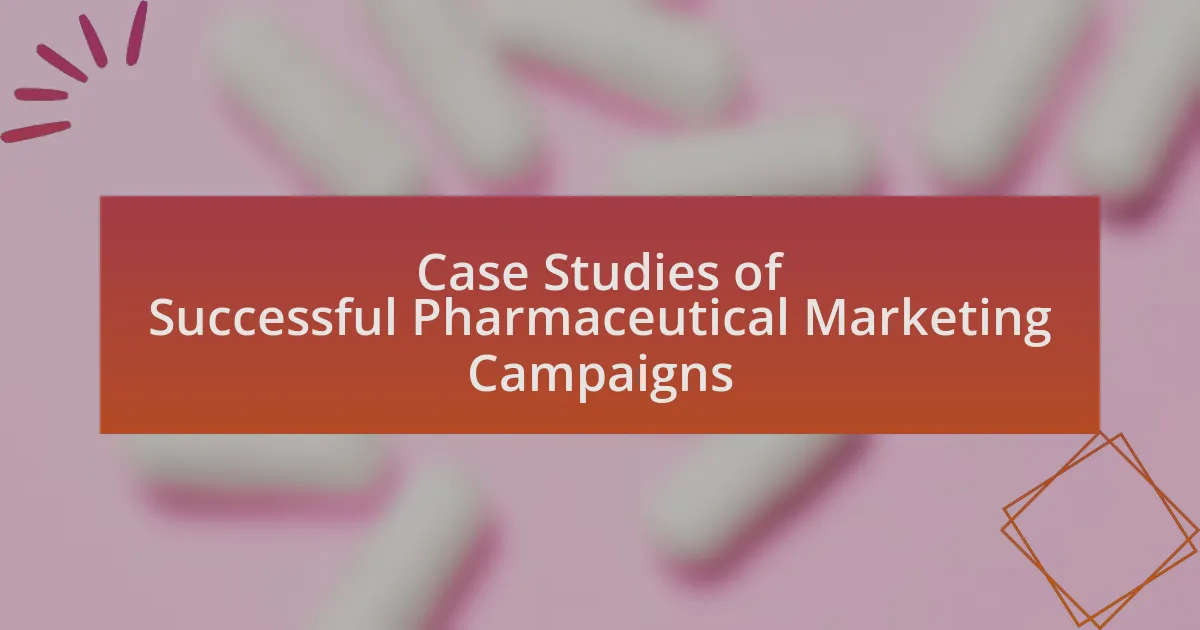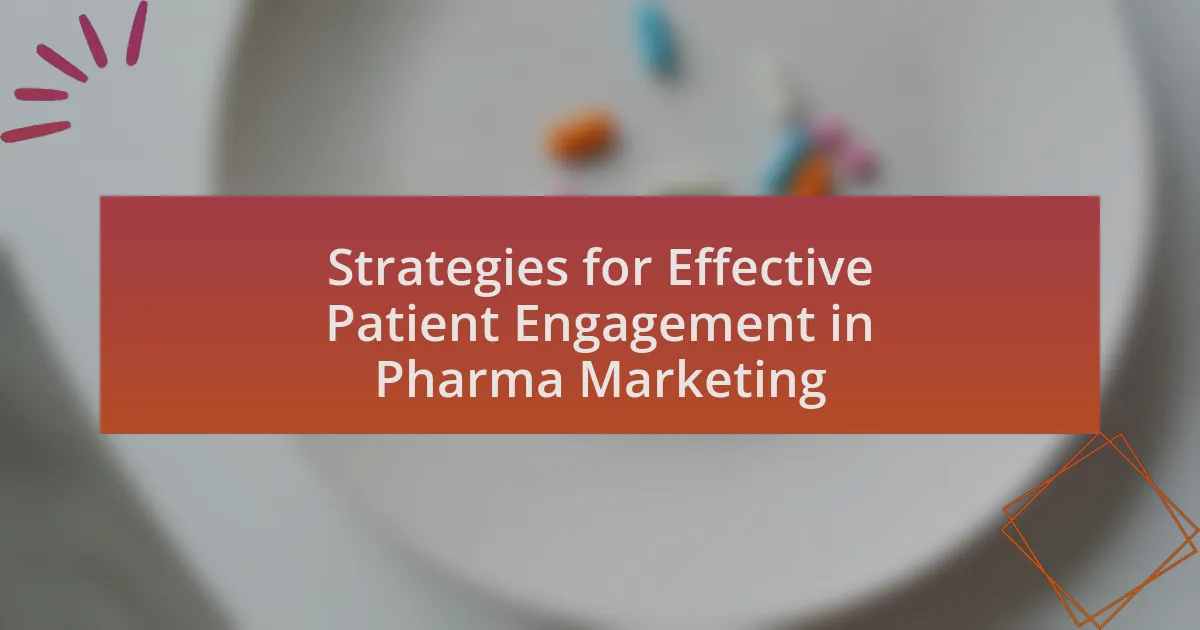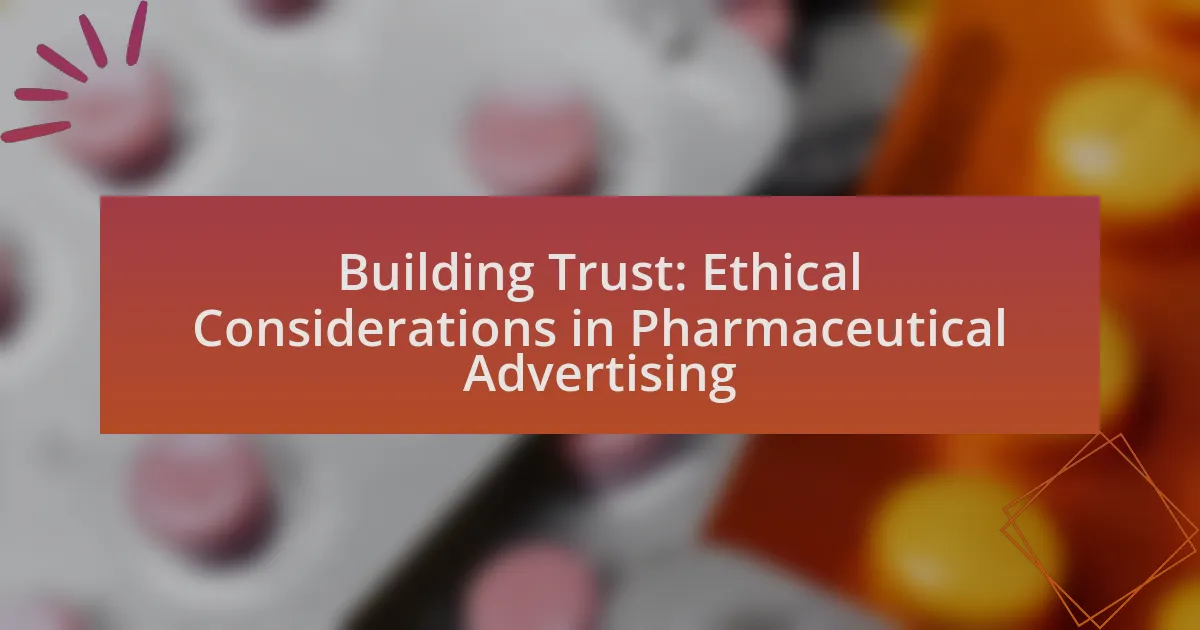Digital marketing is a pivotal component in pharmaceutical promotions, facilitating enhanced communication between pharmaceutical companies, healthcare professionals, and patients. The article explores how digital marketing has transformed traditional promotional methods through targeted advertising, real-time analytics, and personalized marketing strategies. Key strategies discussed include content marketing, search engine optimization (SEO), social media engagement, and email marketing, all of which contribute to improved brand awareness and patient education. Additionally, the article addresses the regulatory challenges faced by pharmaceutical companies in digital marketing and outlines best practices for effective and compliant promotional efforts.
What is the Role of Digital Marketing in Pharmaceutical Promotions?
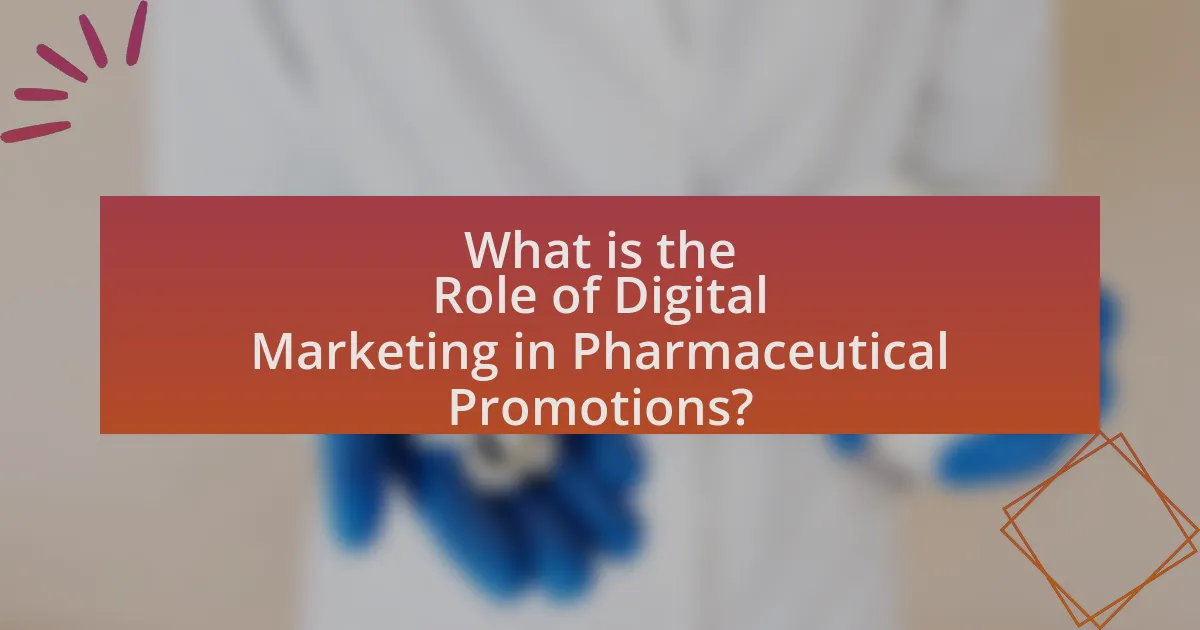
Digital marketing plays a crucial role in pharmaceutical promotions by enhancing communication between pharmaceutical companies and healthcare professionals, as well as patients. It enables targeted advertising, allowing companies to reach specific demographics through channels such as social media, email, and search engines. For instance, a study by the Journal of Medical Internet Research found that digital marketing strategies significantly improve the visibility of pharmaceutical products, leading to increased engagement and awareness among healthcare providers and patients. This targeted approach not only fosters better relationships but also ensures compliance with regulatory standards, making digital marketing an essential tool in the pharmaceutical industry.
How has digital marketing transformed pharmaceutical promotions?
Digital marketing has transformed pharmaceutical promotions by enabling targeted communication and personalized marketing strategies. Traditional promotional methods often relied on broad messaging, but digital platforms allow pharmaceutical companies to segment audiences based on specific demographics, behaviors, and preferences. For instance, the use of social media and search engine marketing has increased engagement rates, with studies showing that digital campaigns can achieve up to 50% higher response rates compared to traditional methods. Additionally, digital marketing facilitates real-time analytics, allowing companies to measure the effectiveness of their campaigns and adjust strategies accordingly, leading to more efficient use of marketing budgets.
What are the key digital marketing strategies used in the pharmaceutical industry?
Key digital marketing strategies used in the pharmaceutical industry include content marketing, search engine optimization (SEO), social media engagement, email marketing, and targeted advertising. Content marketing focuses on providing valuable information to healthcare professionals and patients, enhancing brand credibility and trust. SEO ensures that pharmaceutical websites rank higher in search results, increasing visibility and traffic. Social media engagement allows companies to interact directly with their audience, fostering community and brand loyalty. Email marketing is utilized for personalized communication, keeping stakeholders informed about new products and research. Targeted advertising leverages data analytics to reach specific demographics, optimizing marketing spend and effectiveness. These strategies collectively enhance outreach and engagement in a highly regulated industry.
How do these strategies differ from traditional marketing methods?
Digital marketing strategies differ from traditional marketing methods primarily in their use of technology and data analytics to target specific audiences. Unlike traditional marketing, which often relies on broad channels such as print and television, digital marketing leverages online platforms and tools to engage consumers more directly and personally. For instance, digital marketing allows for real-time tracking of consumer behavior and preferences, enabling pharmaceutical companies to tailor their promotions based on actual data rather than assumptions. This shift is supported by research indicating that targeted digital campaigns can yield conversion rates up to 10 times higher than traditional methods, demonstrating the effectiveness of data-driven approaches in reaching and influencing potential customers.
Why is digital marketing essential for pharmaceutical companies?
Digital marketing is essential for pharmaceutical companies because it enables them to effectively reach and engage healthcare professionals and patients in a highly targeted manner. This approach allows pharmaceutical companies to disseminate critical information about their products, enhance brand awareness, and foster relationships with stakeholders. According to a report by the IMS Institute for Healthcare Informatics, digital channels have become the primary source of information for healthcare professionals, with 70% of physicians using online resources to research medications. This statistic underscores the necessity for pharmaceutical companies to invest in digital marketing strategies to remain competitive and relevant in a rapidly evolving healthcare landscape.
What advantages does digital marketing provide over conventional methods?
Digital marketing offers several advantages over conventional methods, particularly in the context of pharmaceutical promotions. Firstly, digital marketing enables precise targeting of specific demographics, allowing pharmaceutical companies to reach healthcare professionals and patients more effectively. For instance, platforms like Google Ads and social media allow for tailored advertising based on user behavior and preferences, which is not possible with traditional media such as print or television.
Additionally, digital marketing provides real-time analytics, enabling companies to measure campaign performance instantly and adjust strategies accordingly. According to a report by HubSpot, businesses that utilize data-driven marketing strategies can see a 20% increase in sales. This level of adaptability and measurement is significantly more challenging with conventional marketing methods, which often rely on delayed feedback and broader audience assumptions.
Moreover, digital marketing is generally more cost-effective than traditional marketing. A study by the Digital Marketing Association found that digital marketing can be up to 62% cheaper than traditional marketing methods, allowing pharmaceutical companies to allocate resources more efficiently. This cost efficiency, combined with the ability to reach a targeted audience, makes digital marketing a superior choice for pharmaceutical promotions.
How does digital marketing enhance patient engagement and education?
Digital marketing enhances patient engagement and education by providing accessible, tailored information through various online platforms. It allows healthcare providers to share educational content, such as articles, videos, and webinars, directly with patients, fostering a better understanding of health conditions and treatment options. For instance, a study published in the Journal of Medical Internet Research found that patients who engaged with digital health content reported increased knowledge and satisfaction regarding their healthcare decisions. Additionally, social media and email campaigns enable healthcare organizations to interact with patients in real-time, addressing their questions and concerns promptly, which further strengthens the patient-provider relationship.
What are the key components of digital marketing in pharmaceutical promotions?
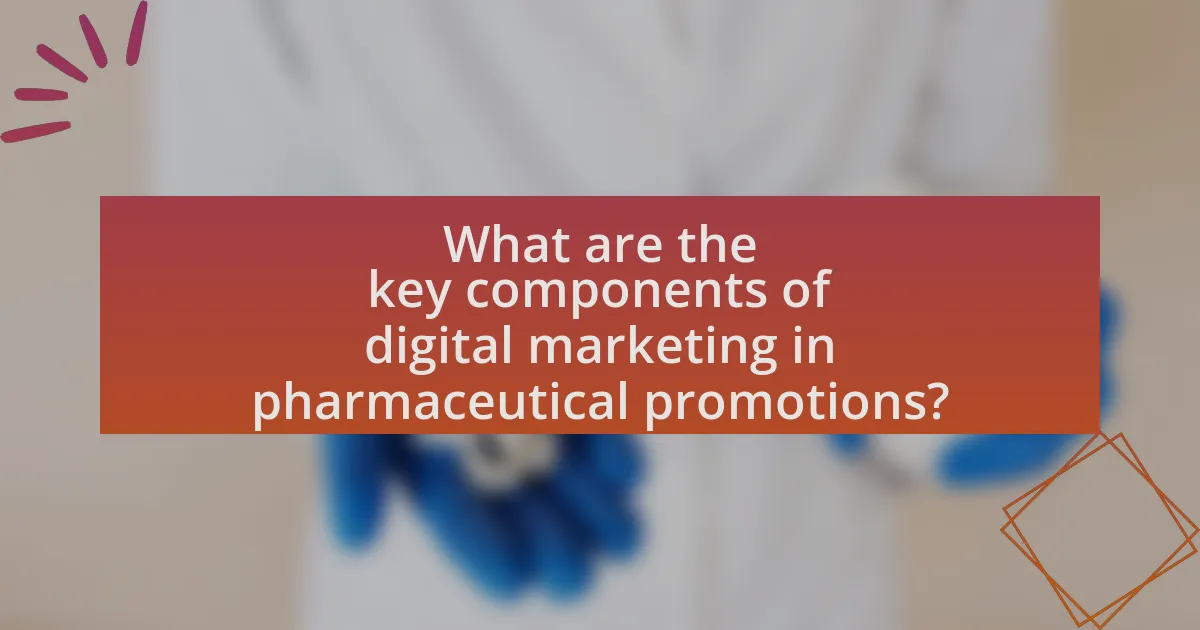
The key components of digital marketing in pharmaceutical promotions include content marketing, social media engagement, search engine optimization (SEO), email marketing, and data analytics. Content marketing focuses on creating informative and compliant materials that educate healthcare professionals and patients about products. Social media engagement allows pharmaceutical companies to interact with their audience, share updates, and promote brand awareness while adhering to regulatory guidelines. SEO enhances the visibility of pharmaceutical websites in search engine results, driving organic traffic. Email marketing facilitates direct communication with healthcare providers and patients, delivering personalized information and updates. Data analytics enables companies to measure the effectiveness of their campaigns, understand audience behavior, and optimize strategies for better results. These components collectively enhance the reach and impact of pharmaceutical promotions in the digital landscape.
What role do social media platforms play in pharmaceutical marketing?
Social media platforms play a crucial role in pharmaceutical marketing by enabling direct engagement with consumers and healthcare professionals. These platforms facilitate the dissemination of information about drugs, health conditions, and treatment options, allowing pharmaceutical companies to reach a broader audience. For instance, a study published in the Journal of Medical Internet Research found that 70% of patients use social media to seek health information, highlighting its significance in influencing patient decisions. Additionally, social media allows for targeted advertising, enabling companies to tailor their messages based on user demographics and interests, which can enhance the effectiveness of marketing campaigns.
How can pharmaceutical companies effectively utilize social media for promotions?
Pharmaceutical companies can effectively utilize social media for promotions by creating targeted content that educates and engages their audience while adhering to regulatory guidelines. By leveraging platforms like Facebook, Twitter, and LinkedIn, these companies can share informative posts, videos, and infographics that highlight their products, research findings, and health-related topics. According to a study published in the Journal of Medical Internet Research, 70% of patients reported that social media influenced their healthcare decisions, demonstrating the potential impact of well-crafted social media strategies. Additionally, engaging with healthcare professionals and patients through interactive content, such as Q&A sessions and live webinars, can enhance trust and foster community engagement, ultimately driving brand awareness and loyalty.
What are the potential risks associated with social media marketing in this sector?
The potential risks associated with social media marketing in the pharmaceutical sector include regulatory compliance issues, misinformation dissemination, and reputational damage. Regulatory compliance is critical, as pharmaceutical companies must adhere to strict guidelines set by authorities like the FDA, which can lead to penalties if not followed. Misinformation can spread rapidly on social media, potentially leading to public health risks and legal liabilities. Reputational damage can occur if a company is perceived as promoting products irresponsibly or if negative feedback goes viral, impacting consumer trust. These risks highlight the need for careful management and strategic planning in social media marketing within the pharmaceutical industry.
How do search engine optimization (SEO) and content marketing contribute?
Search engine optimization (SEO) and content marketing contribute significantly to enhancing online visibility and engagement in pharmaceutical promotions. SEO improves the ranking of pharmaceutical websites on search engines, making them more accessible to potential customers, while content marketing provides valuable information that attracts and retains these customers. For instance, a study by HubSpot found that companies that prioritize blogging are 13 times more likely to achieve a positive ROI, demonstrating the effectiveness of content marketing in driving traffic and conversions. Together, these strategies create a synergistic effect that boosts brand awareness and customer trust in the pharmaceutical industry.
What are the best practices for SEO in pharmaceutical digital marketing?
The best practices for SEO in pharmaceutical digital marketing include optimizing website content for relevant keywords, ensuring compliance with regulatory guidelines, and enhancing user experience. Optimizing content involves using specific medical and pharmaceutical terms that potential patients and healthcare professionals search for, which can improve visibility in search engine results. Compliance with regulations, such as those set by the FDA, is crucial to avoid penalties and maintain credibility. Enhancing user experience through fast loading times, mobile optimization, and easy navigation can lead to lower bounce rates and higher engagement, which are favorable for SEO rankings. According to a study by HubSpot, 75% of users never scroll past the first page of search results, emphasizing the importance of effective SEO strategies in reaching target audiences.
How can content marketing improve brand awareness and trust?
Content marketing can improve brand awareness and trust by providing valuable, relevant information that engages the target audience. When pharmaceutical companies create informative content, such as articles, videos, and infographics about health topics, they position themselves as knowledgeable and trustworthy sources. According to a study by the Content Marketing Institute, 70% of consumers prefer to learn about a company through articles rather than ads, indicating that informative content can enhance brand visibility and credibility. Furthermore, consistent and transparent communication through content marketing fosters a sense of reliability, which is crucial in the pharmaceutical industry where trust is paramount for patient safety and compliance.
What challenges do pharmaceutical companies face in digital marketing?
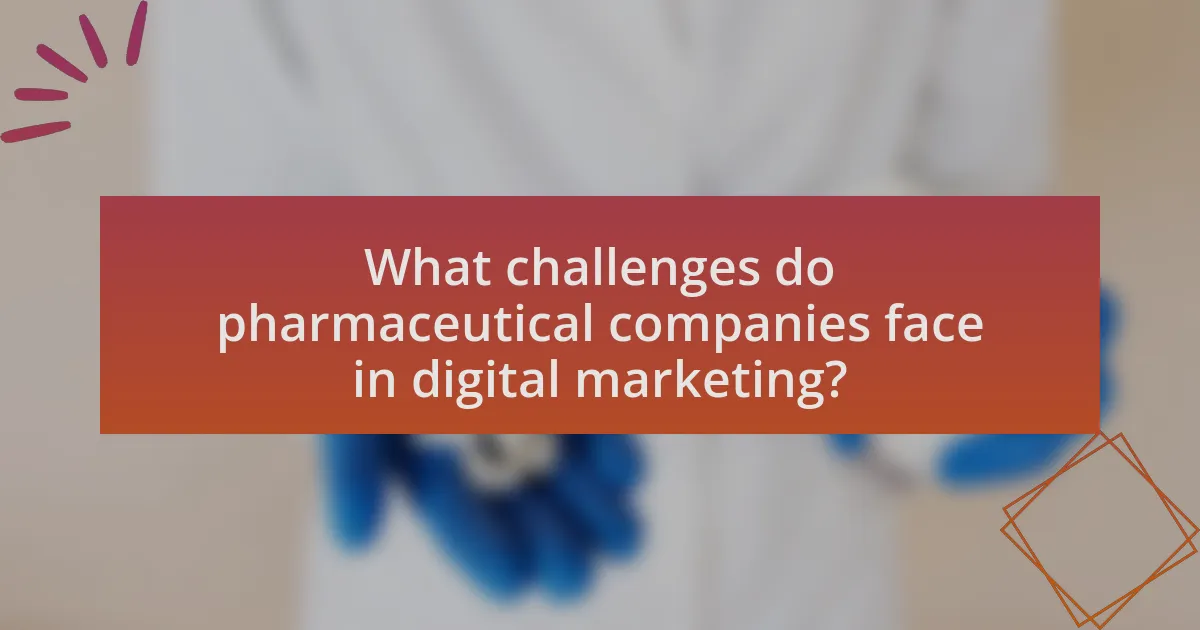
Pharmaceutical companies face significant challenges in digital marketing, primarily due to stringent regulatory requirements. These regulations, enforced by agencies like the FDA, restrict how companies can promote their products online, limiting claims and necessitating extensive disclaimers. Additionally, the complexity of the healthcare landscape complicates targeting and messaging, as companies must navigate diverse audiences, including healthcare professionals and patients, each with unique needs and compliance considerations. Furthermore, data privacy concerns, particularly with regulations like HIPAA, restrict how companies can collect and utilize consumer data for targeted marketing efforts. These factors collectively hinder the effectiveness and reach of digital marketing strategies in the pharmaceutical sector.
How do regulatory constraints impact digital marketing strategies?
Regulatory constraints significantly impact digital marketing strategies by imposing strict guidelines on how pharmaceutical companies can promote their products. These regulations, such as the FDA’s requirements for advertising prescription drugs, dictate the content, format, and channels used for marketing, ensuring that claims are substantiated and that risks are clearly communicated. For instance, the FDA mandates that promotional materials must include information about side effects and contraindications, which can limit the creative freedom of marketers. Consequently, pharmaceutical companies must develop strategies that comply with these regulations while still effectively reaching their target audiences, often leading to more conservative and risk-averse marketing approaches.
What are the key regulations that pharmaceutical companies must adhere to?
Pharmaceutical companies must adhere to key regulations such as the Food, Drug, and Cosmetic Act, the Drug Enforcement Administration regulations, and the guidelines set forth by the Food and Drug Administration. These regulations ensure the safety, efficacy, and security of pharmaceutical products. For instance, the Food, Drug, and Cosmetic Act mandates that all drugs must be proven safe and effective before they can be marketed, while the Drug Enforcement Administration regulates controlled substances to prevent abuse. Additionally, the FDA provides specific guidelines for advertising and promotional materials to ensure that they are not misleading and provide balanced information about risks and benefits.
How can companies navigate these regulations while still being effective?
Companies can navigate regulations in pharmaceutical promotions by implementing robust compliance frameworks that align with legal standards while leveraging digital marketing strategies. Establishing a dedicated compliance team ensures that all marketing materials adhere to guidelines set by regulatory bodies such as the FDA and EMA. Additionally, utilizing data analytics can help companies target their audience effectively without violating privacy laws, as seen in the 2020 FDA guidelines that emphasize transparency in digital advertising. By integrating compliance checks into the marketing process, companies can maintain effectiveness while minimizing the risk of regulatory breaches.
What are the common pitfalls in digital marketing for pharmaceuticals?
Common pitfalls in digital marketing for pharmaceuticals include regulatory non-compliance, inadequate targeting, and poor content strategy. Regulatory non-compliance occurs when pharmaceutical companies fail to adhere to guidelines set by authorities like the FDA, which can lead to legal repercussions. Inadequate targeting results from not effectively identifying and reaching the appropriate audience, diminishing campaign effectiveness. Poor content strategy often manifests as generic messaging that does not resonate with healthcare professionals or patients, leading to low engagement rates. These pitfalls can significantly hinder the success of digital marketing efforts in the pharmaceutical sector.
How can companies avoid miscommunication with healthcare professionals and patients?
Companies can avoid miscommunication with healthcare professionals and patients by implementing clear and consistent communication strategies. Establishing standardized messaging across all platforms ensures that both healthcare providers and patients receive the same information, reducing the risk of misunderstandings. Utilizing digital marketing tools, such as targeted email campaigns and informative websites, allows companies to convey complex medical information in an accessible manner. Research indicates that 70% of healthcare professionals prefer receiving information through digital channels, highlighting the importance of leveraging these platforms for effective communication. Additionally, regular feedback loops with healthcare professionals can help identify areas of confusion and improve messaging clarity.
What strategies can mitigate the risk of misinformation in digital campaigns?
To mitigate the risk of misinformation in digital campaigns, implementing fact-checking protocols is essential. Fact-checking involves verifying the accuracy of information before it is disseminated, which can significantly reduce the spread of false claims. Research by the Pew Research Center indicates that 64% of Americans believe that misinformation is a major problem, highlighting the need for rigorous verification processes. Additionally, utilizing transparent communication strategies, such as clearly citing sources and providing evidence for claims, fosters trust and accountability. A study published in the Journal of Medical Internet Research found that transparency in health communication improves audience trust and reduces the likelihood of misinformation. Engaging with credible experts and organizations to validate information can further enhance the reliability of digital content.
What best practices should pharmaceutical companies follow in digital marketing?
Pharmaceutical companies should prioritize compliance, transparency, and targeted audience engagement in their digital marketing strategies. Compliance with regulations such as the FDA guidelines ensures that marketing practices are legal and ethical, which is crucial in the highly regulated pharmaceutical industry. Transparency in communication builds trust with healthcare professionals and patients, fostering a positive brand image. Additionally, utilizing data analytics to understand target audiences allows for personalized marketing efforts, which can enhance engagement and improve the effectiveness of campaigns. For instance, a study by the Journal of Medical Internet Research found that targeted digital marketing significantly increased patient engagement and awareness of treatment options.
How can companies measure the effectiveness of their digital marketing efforts?
Companies can measure the effectiveness of their digital marketing efforts through key performance indicators (KPIs) such as conversion rates, return on investment (ROI), and engagement metrics. By analyzing conversion rates, companies can determine the percentage of users who complete desired actions, indicating the success of their campaigns. ROI calculations help assess the financial return relative to the marketing spend, providing a clear picture of profitability. Engagement metrics, including click-through rates and social media interactions, offer insights into audience interest and content effectiveness. According to a report by HubSpot, businesses that prioritize blogging are 13 times more likely to achieve a positive ROI, highlighting the importance of content strategy in digital marketing effectiveness.
What tools and metrics are essential for tracking success in pharmaceutical promotions?
Essential tools and metrics for tracking success in pharmaceutical promotions include Customer Relationship Management (CRM) systems, analytics platforms, and key performance indicators (KPIs) such as return on investment (ROI), engagement rates, and conversion rates. CRM systems enable pharmaceutical companies to manage interactions with healthcare professionals and patients, providing insights into customer behavior and preferences. Analytics platforms, like Google Analytics, allow for the measurement of website traffic and user engagement, helping to assess the effectiveness of digital campaigns. KPIs such as ROI quantify the financial return on promotional activities, while engagement rates measure the level of interaction with promotional content, and conversion rates indicate the percentage of targeted audiences taking desired actions, such as requesting more information or making a purchase. These tools and metrics collectively provide a comprehensive view of promotional effectiveness, guiding strategic adjustments and optimizing future campaigns.
